light switch SKODA OCTAVIA 2007 1.G / (1U) Manual PDF
[x] Cancel search | Manufacturer: SKODA, Model Year: 2007, Model line: OCTAVIA, Model: SKODA OCTAVIA 2007 1.G / (1U)Pages: 288, PDF Size: 15.19 MB
Page 137 of 288

Automatic gearbox DSG
136
Tiptronic
The Tiptronic allows the driver to also shift gears manually.
Switching over to manual shifting
– Push the selector lever to the right out of position D. As soon as the
gearbox has switched over, 6 5 4 3 2 1 appears in the display, with the
gear engaged being highlighted ⇒fig. 147 .
Shifting up gears
– One-touch forward of the selector lever (in the Tiptronic position)
⇒ fig. 146 . Shifting down gears
– One-touch back of the selector lever (in the Tiptronic position) .
It is possible to switch over to manual both when the car is stationary and also when
driving.
When you accelerate, the gearbox shifts up
automatically in gears 1, 2, 3, 4 and 5
into the next higher gear just before the maximum permissible engine speed is
reached.
If you select a lower gear, the automatic gearbox does not shift down until there is
no risk of the engine overrevving. (Does not apply for the shifting from 2nd to 1st
gear.)
If you operate the kickdown function, the ge arbox shifts into a lower gear in line
with the vehicle speed and engine speed.
Emergency programme
An emergency programme exists in the event of a fault in the system.
The gearbox operates in a corresponding emergency programme if there are func-
tional faults in the gearbox electronics. This is indicated by all of the segments in the
display lighting up or going out.
A functional fault can have the following effect:
•The gearbox only shifts into certain gears.
•The reverse gear R cannot be used.
•The manual shift programme (Tiptronic) is switched off in the emergency mode.
If the gearbox has switched over to emergency mode, drive to the nearest
specialist garage in order to have the fault rectified.
Fig. 146 Selector lever:
Manual shifting of gears
Fig. 147 Information
display: Manual shifting
of gears
A+
A-
NKO A5 20 MR08.book Page 136 Wednesday, April 11, 2007 2:54 PM
Page 139 of 288
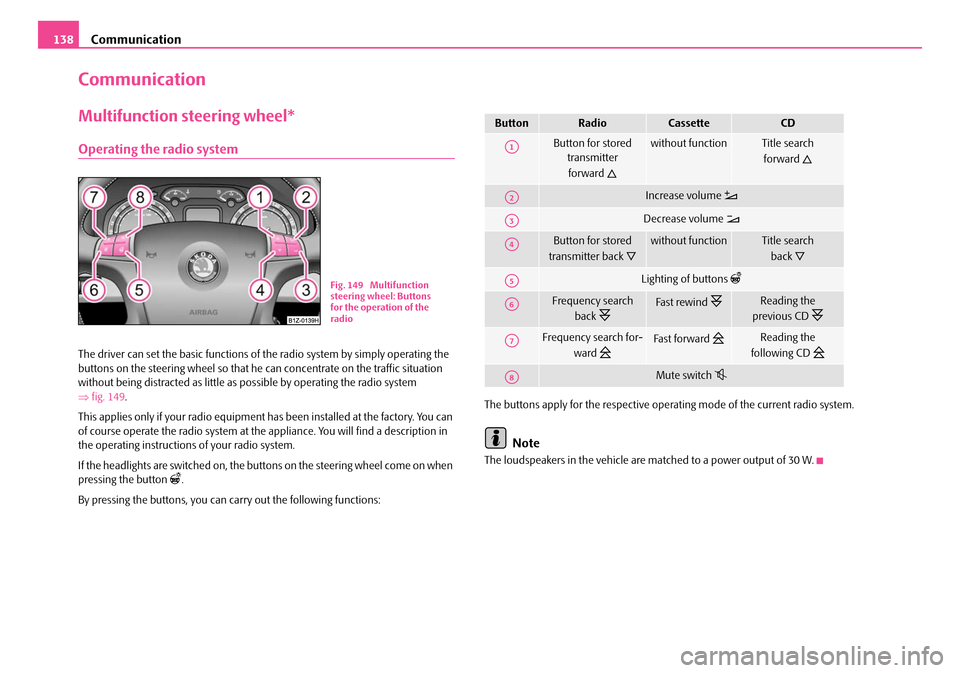
Communication
138
Communication
Multifunction steering wheel*
Operating the radio system
The driver can set the basic functions of the radio system by simply operating the
buttons on the steering wheel so that he can concentrate on the traffic situation
without being distracted as little as possible by operating the radio system
⇒ fig. 149 .
This applies only if your radio equipment has been installed at the factory. You can
of course operate the radio system at the appliance. You will find a description in
the operating instructions of your radio system.
If the headlights are switched on, the bu ttons on the steering wheel come on when
pressing the button
.
By pressing the buttons, you can carry out the following functions: The buttons apply for the respective operating mode of the current radio system.
Note
The loudspeakers in the vehicle are
matched to a power output of 30 W.
Fig. 149 Multifunction
steering wheel: Buttons
for the operation of the
radio
ButtonRadioCassetteCD
Button for stored
transmitter
forward
without functionTitle search forward
Increase volume
Decrease volume
Button for stored
transmitter back
without functionTitle search back
Lighting of buttons
Frequency search back
Fa s t re w i n d Reading the
previous CD
Frequency search for- ward
Fa s t fo r w a rd Reading the
following CD
Mute switch
A1
A2
A3
A4
A5
A6
A7
A8
NKO A5 20 MR08.book Page 138 Wednesday, April 11, 2007 2:54 PM
Page 140 of 288
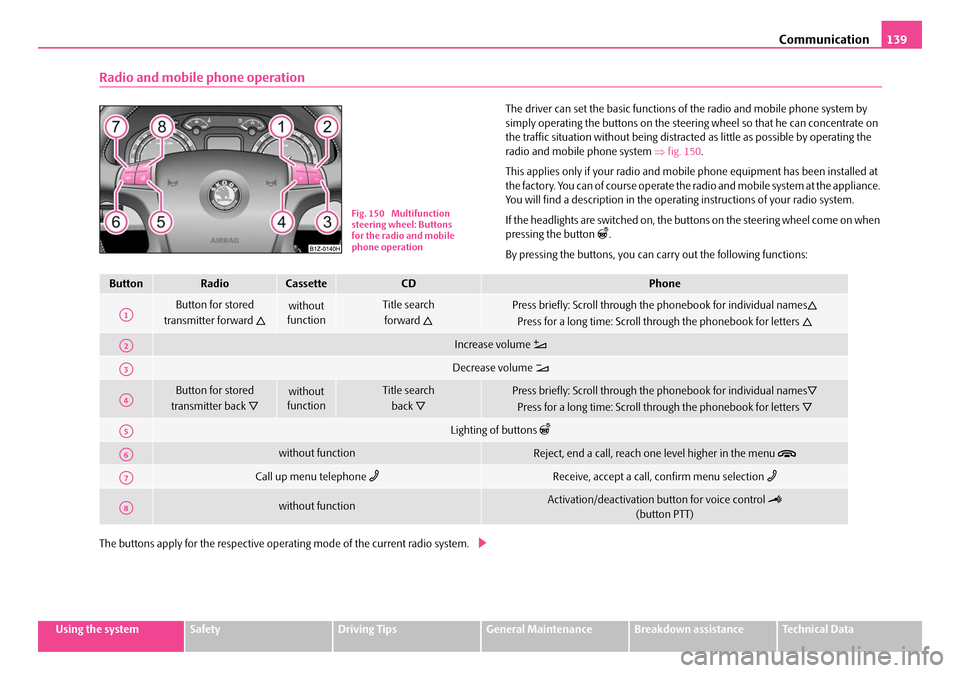
Communication139
Using the systemSafetyDriving TipsGeneral MaintenanceBreakdown assistanceTechnical Data
Radio and mobile phone operation
The driver can set the basic functions of the radio and mobile phone system by
simply operating the buttons on the steering wheel so that he can concentrate on
the traffic situation without being distracted as little as possible by operating the
radio and mobile phone system ⇒fig. 150 .
This applies only if your radio and mobi le phone equipment has been installed at
the factory. You can of course operate the radio and mobile system at the appliance.
You will find a description in the operating instructions of your radio system.
If the headlights are switched on, the buttons on the steering wheel come on when
pressing the button
.
By pressing the buttons, you can carry out the following functions:
The buttons apply for the respective operating mode of the current radio system.
Fig. 150 Multifunction
steering wheel: Buttons
for the radio and mobile
phone operation
ButtonRadioCassetteCDPhone
Button for stored
transmitter forward
without
functionTitle search
forward
Press briefly: Scroll through the phonebook for individual names
Press for a long time: Scroll through the phonebook for letters
Increase volume
Decrease volume
Button for stored
transmitter back
without
functionTitle search
back
Press briefly: Scroll through the phonebook for individual names
Press for a long time: Scroll through the phonebook for letters
Lighting of buttons
without functionReject, end a call, reach one level higher in the menu
Call up menu telephone Receive, accept a call, confirm menu selection
without functionActivation/deactivation button for voice control
(button PTT)
A1
A2
A3
A4
A5
A6
A7
A8
NKO A5 20 MR08.book Page 139 Wednesday, April 11, 2007 2:54 PM
Page 164 of 288
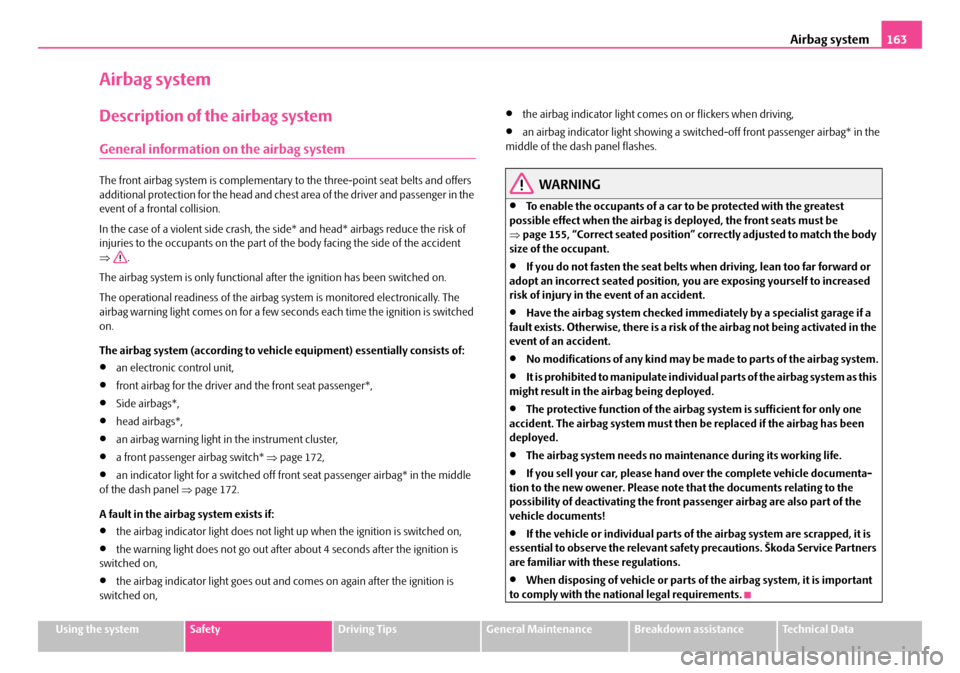
Airbag system163
Using the systemSafetyDriving TipsGeneral MaintenanceBreakdown assistanceTechnical Data
Airbag system
Description of the airbag system
General information on the airbag system
The front airbag system is complementary to the three-point seat belts and offers
additional protection for the head and chest area of the driver and passenger in the
event of a frontal collision.
In the case of a violent side crash, the si de* and head* airbags reduce the risk of
injuries to the occupants on the part of the body facing the side of the accident
⇒ .
The airbag system is only functional af ter the ignition has been switched on.
The operational readiness of the airbag system is monitored electronically. The
airbag warning light comes on for a few seconds each time the ignition is switched
on.
The airbag system (according to vehicl e equipment) essentially consists of:
•an electronic control unit,
•front airbag for the driver and the front seat passenger*,
•Side airbags*,
•head airbags*,
•an airbag warning light in the instrument cluster,
•a front passenger airbag switch* ⇒page 172,
•an indicator light for a switched off front seat passenger airbag* in the middle
of the dash panel ⇒page 172.
A fault in the airbag system exists if:
•the airbag indicator light do es not light up when the ignition is switched on,
•the warning light does not go out after about 4 seconds after the ignition is
switched on,
•the airbag indicator light goes out and comes on again after the ignition is
switched on,
•the airbag indicator light comes on or flickers when driving,
•an airbag indicator light showing a swit ched-off front passenger airbag* in the
middle of the dash panel flashes.
WARNING
•To enable the occupants of a car to be protected with the greatest
possible effect when the airbag is deployed, the front seats must be
⇒ page 155, “Correct seated position” co rrectly adjusted to match the body
size of the occupant.
•If you do not fasten the seat belts when driving, lean too far forward or
adopt an incorrect seated position, you are exposing yourself to increased
risk of injury in the event of an accident.
•Have the airbag system checked immedi ately by a specialist garage if a
fault exists. Otherwise, there is a risk of the airbag not being activated in the
event of an accident.
•No modifications of any kind may be made to parts of the airbag system.
•It is prohibited to manipulate individual parts of the airbag system as this
might result in the airbag being deployed.
•The protective function of the airbag system is sufficient for only one
accident. The airbag system must then be replaced if the airbag has been
deployed.
•The airbag system needs no main tenance during its working life.
•If you sell your car, please hand over the complete vehicle documenta-
tion to the new owener. Please note that the documents relating to the
possibility of deactivating the front passenger airbag are also part of the
vehicle documents!
•If the vehicle or individual parts of the airbag system are scrapped, it is
essential to observe the relevant safety precautions. Škoda Service Partners
are familiar with these regulations.
•When disposing of vehicle or parts of the airbag system, it is important
to comply with the national legal requirements.
NKO A5 20 MR08.book Page 163 Wednesday, April 11, 2007 2:54 PM
Page 165 of 288

Airbag system
164
When are the airbags deployed?
The airbag system is designed in such a way that the driver airbag and the front
passenger airbag* are deployed in the event of a frontal collision of major severity.
In the case of a violent side crash , the side airbag* on the side of the car at which
the collision occurs, is deployed together with the head airbag*.
In certain accident situations it is possible that both the front as well as the side
airbags and the relevant head airbag are deployed at the same time.
The airbags are not deployed in the case of minor frontal and side collisions, in the
case of rear-end collisi ons and vehicle rollover.
Deployment factors
It is not possible to state globally which deployment conditions apply to the airbag
system in every situation as the circumstances which exist in the case of accidents
vary greatly. An important role in this case , for example, is played by factors such as
the type of object against which the vehicle impacts (hard, soft), the angle of impact,
the vehicle speed etc.
A decisive factor for the deployment of the airbags is the deceleration which occurs
during a collision. The control unit analyses the nature of the collision and activates
the relevant restraint system. If the vehicle deceleration which occurs and is meas-
ured during the collision remains below the prescribed reference values specified
in the control unit, the airbags are not deployed although the vehicle may well
suffer severe damage to the bodywork as a consequence of the accident.
The airbags are not deployed if:
•ignition off,
•a minor frontal collision,
•a minor side collision,
•a rear-end collision,
•rollover.
Note
•A grey white, non harmful gas is released when airbag is inflated. This is
perfectly normal and is not an indi cation of a fire in the vehicle.
•The dash panel must be replaced afte r the front passenger airbag has been
deployed.
•In the event of an accident in which the airbags are deployed:
− The interior lighting comes on (if the swit ch for the interior light is in the door
contact position),
− The hazard warning light is switched on,
− All the doors are unlocked,
− the fuel supply to the engine is interrupted.
NKO A5 20 MR08.book Page 164 Wednesday, April 11, 2007 2:54 PM
Page 171 of 288
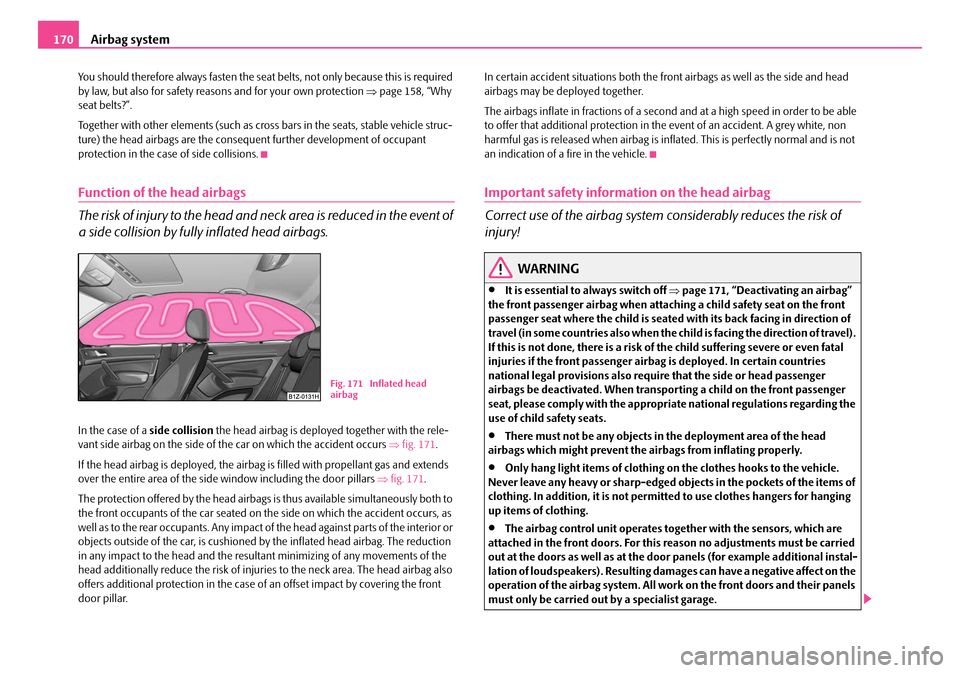
Airbag system
170
You should therefore always fasten the seat belts, not only because this is required
by law, but also for safety reasons and for your own protection ⇒page 158, “Why
seat belts?”.
Together with other elements (such as cros s bars in the seats, stable vehicle struc-
ture) the head airbags are the conseque nt further development of occupant
protection in the case of side collisions.
Function of the head airbags
The risk of injury to the head and neck area is reduced in the event of
a side collision by fully inflated head airbags.
In the case of a side collision the head airbag is deployed together with the rele-
vant side airbag on the side of th e car on which the accident occurs ⇒fig. 171 .
If the head airbag is deployed, the airbag is filled with propellant gas and extends
over the entire area of the side window including the door pillars ⇒fig. 171 .
The protection offered by the head airbags is thus available simultaneously both to
the front occupants of the car seated on th e side on which the accident occurs, as
well as to the rear occupants. Any impact of the head against parts of the interior or
objects outside of the car, is cushioned by the inflated head airbag. The reduction
in any impact to the head and the result ant minimizing of any movements of the
head additionally reduce the risk of injuries to the neck area. The head airbag also
offers additional protection in the case of an offset impact by covering the front
door pillar. In certain accident situations
both the front airbags as well as the side and head
airbags may be deployed together.
The airbags inflate in fractions of a second and at a high speed in order to be able
to offer that additional protection in the event of an accident. A grey white, non
harmful gas is released when airbag is infl ated. This is perfectly normal and is not
an indication of a fire in the vehicle.
Important safety information on the head airbag
Correct use of the airbag system considerably reduces the risk of
injury!
WARNING
•It is essential to always switch off ⇒page 171, “Deactivating an airbag”
the front passenger airbag when attach ing a child safety seat on the front
passenger seat where the child is seated with its back facing in direction of
travel (in some countries al so when the child is facing the direction of travel).
If this is not done, there is a risk of the child suffering severe or even fatal
injuries if the front passenger airbag is deployed. In certain countries
national legal provisions also requir e that the side or head passenger
airbags be deactivated. When transporting a child on the front passenger
seat, please comply with the appropri ate national regulations regarding the
use of child safety seats.
•There must not be any objects in the deployment area of the head
airbags which might prevent the airbags from inflating properly.
•Only hang light items of clothing on the clothes hooks to the vehicle.
Never leave any heavy or sh arp-edged objects in the pockets of the items of
clothing. In addition, it is not permit ted to use clothes hangers for hanging
up items of clothing.
•The airbag control unit operates together with the sensors, which are
attached in the front doors. For this reason no adjustments must be carried
out at the doors as well as at the door panels (for example additional instal-
lation of loudspeakers). Resulting dama ges can have a negative affect on the
operation of the airbag system. All work on the front doors and their panels
must only be carried out by a specialist garage.
Fig. 171 Inflated head
airbag
NKO A5 20 MR08.book Page 170 Wednesday, April 11, 2007 2:54 PM
Page 172 of 288

Airbag system171
Using the systemSafetyDriving TipsGeneral MaintenanceBreakdown assistanceTechnical Data
•There must not be any other persons (e.g. children) or animals between
the car occupant and the deployment ar ea of the head airbag. In addition,
none of the occupants should lean their head out of the window when
driving, or extend their arms and hands out of the window.
•The sun visors must not be swivelled to the side windows into the
deployment area of the head airbags if any objects, such as ball-point pens
etc. are attached to them. This might result in injuries to the occupants if the
head airbag is deployed.
•Installing impermissible accessories in the area of the head airbags may
considerably impair the protection offered by the head airbag in the event of
it being deployed. When the deployed head airbag is inflated, parts of the
accessories fitted may in certain circumstances be thrown into the interior
of the car and cause injuries to the occupants ⇒page 229, “Accessories,
changes and replacement of parts”.
•Any work on the head airbag system including installing and removing
system components because of other re pair work (e.g. removing headliner)
must only be carried ou t by a specialist garage.
Deactivating an airbag
Deactivating airbags
If any airbags have been deactivated, switch them on again as soon
as possible so that they are able to again provide their proper protec-
tion.
There is the technical means installed within your vehicle to switch off the front,
side* or head airbag* (take out of commission).
This is why you should have the deactiva tion of the airbags carried out by a
specialist garage.
On vehicles equipped with the switch for deactivation of the airbags, you can deac-
tivate the front and side passenger airbag by means of this switch ⇒page 172. Deactivation of airbags is envisaged only for particular instances, such as if:
•you must
in exceptional cases use a child seat on the front passenger seat
where the child has its back to the directio n of travel of the vehicle (in some coun-
tries this must be in the direction of travel due to other legal regulations applying)
⇒ page 173, “Important safety information regarding the use of child safety seats”
•you are not able to maintain the distance of at least 25 cm between middle of
steering wheel and chest, despite the driver seat being correctly adjusted,
•special attachments are required in the area of the steering wheel because of a
physical disability,
•you have installed other seats (e.g. orthopaedic seats without side airbags).
Monitoring the airbag system
The functionality of the airbag system is also monitored electronically, when one
airbag has been switched off
If the airbag was switched of f using diagnostic equipment:
•The warning light for the airbag system lights up for 4 seconds after switching
on the ignition and then flashes for 12 seconds afterwards in 2 second intervals.
Front passenger airbags switched off using the switch for front passenger
airbags* in stowage compartmen t on the front passenger side:
•The airbag warning light comes on in the instrument cluster for about 4 seconds
each time the ignition is switched on.
•Switching off airbags is indicated in the middle of the dash panel by the lighting
up of the indicator light ⇒ page 172, fig. 173 .
Note
Your Škoda Service Partner will be able to advise you whether national legislation in
your country allows airbags in your vehi cle to be deactivated, and which ones.
WARNING (continued)
NKO A5 20 MR08.book Page 171 Wednesday, April 11, 2007 2:54 PM
Page 173 of 288
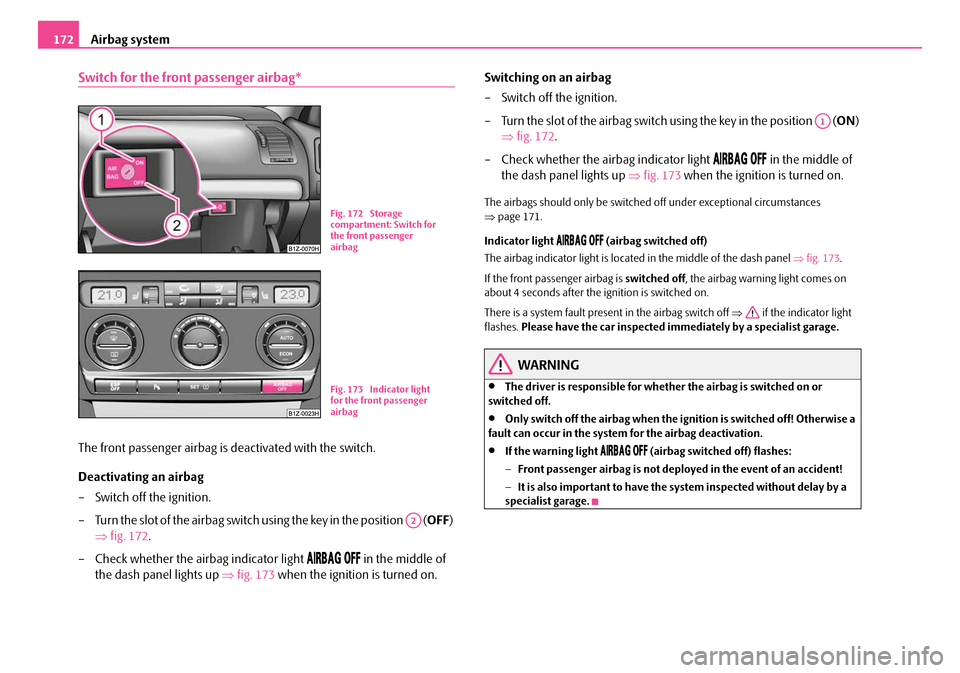
Airbag system
172
Switch for the front passenger airbag*
The front passenger airbag is deactivated with the switch.
Deactivating an airbag
– Switch off the ignition.
– Turn the slot of the airbag switch using the key in the position ( OFF)
⇒ fig. 172 .
– Check whether the airbag indicator light
in the middle of
the dash panel lights up ⇒fig. 173 when the ignition is turned on. Switching on an airbag
– Switch off the ignition.
– Turn the slot of the airbag switch using the key in the position (
ON)
⇒ fig. 172 .
– Check whether the airbag indicator light
in the middle of
the dash panel lights up ⇒ fig. 173 when the ignition is turned on.
The airbags should only be switched off under exceptional circumstances
⇒ page 171.
Indicator light
(airbag switched off)
The airbag indicator light is locate d in the middle of the dash panel ⇒fig. 173 .
If the front passenger airbag is switched off, the airbag warning light comes on
about 4 seconds after the ignition is switched on.
There is a system fault presen t in the airbag switch off ⇒ if the indicator light
flashes. Please have the car inspected immediately by a specialist garage.
WARNING
•The driver is responsible for whether the airbag is switched on or
switched off.
•Only switch off the airbag when the ignition is switched off! Otherwise a
fault can occur in the system for the airbag deactivation.
•If the warning light (airbag switched off) flashes:
− Front passenger airbag is not deploy ed in the event of an accident!
− It is also important to have the system inspected without delay by a
specialist garage.
Fig. 172 Storage
compartment: Switch for
the front passenger
airbag
Fig. 173 Indicator light
for the front passenger
airbag
A2
A1
NKO A5 20 MR08.book Page 172 Wednesday, April 11, 2007 2:54 PM
Page 182 of 288
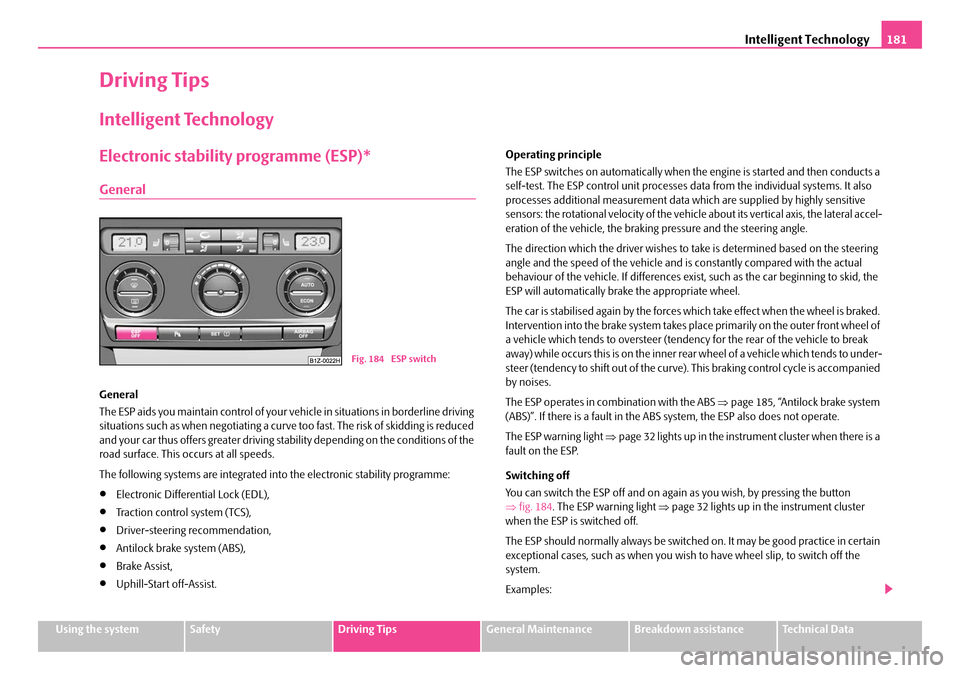
Intelligent Technology181
Using the systemSafetyDriving TipsGeneral MaintenanceBreakdown assistanceTechnical Data
Driving Tips
Intelligent Technology
Electronic stability programme (ESP)*
General
General
The ESP aids you maintain control of your vehicle in situations in borderline driving
situations such as when negotiating a curve too fast. The risk of skidding is reduced
and your car thus offers greater driving stability depending on the conditions of the
road surface. This occurs at all speeds.
The following systems are integrated into the electronic stability programme:
•Electronic Differential Lock (EDL),
•Traction control system (TCS),
•Driver-steering recommendation,
•Antilock brake system (ABS),
•Brake Assist,
•Uphill-Start off-Assist. Operating principle
The ESP switches on automatically when the engine is started and then conducts a
self-test. The ESP control unit processes data from the individual systems. It also
processes additional measurement data which are supplied by highly sensitive
sensors: the rotational velocity of the vehi
cle about its vertical axis, the lateral accel-
eration of the vehicle, the brakin g pressure and the steering angle.
The direction which the driver wishes to ta ke is determined based on the steering
angle and the speed of the vehicle and is constantly compared with the actual
behaviour of the vehicle. If differences exis t, such as the car beginning to skid, the
ESP will automatically brake the appropriate wheel.
The car is stabilised again by the forces which take effect when the wheel is braked.
Intervention into the brake system takes place primarily on the outer front wheel of
a vehicle which tends to oversteer (tendency for the rear of the vehicle to break
away) while occurs this is on the inner re ar wheel of a vehicle which tends to under-
steer (tendency to shift out of the curve). This braking control cycle is accompanied
by noises.
The ESP operates in combination with the ABS ⇒page 185, “Antilock brake system
(ABS)”. If there is a fault in the ABS system, the ESP also does not operate.
The ESP warning light ⇒page 32 lights up in the instrument cluster when there is a
fault on the ESP.
Switching off
You can switch the ESP off and on again as you wish, by pressing the button
⇒ fig. 184 . The ESP warning light ⇒page 32 lights up in the instrument cluster
when the ESP is switched off.
The ESP should normally always be switched on. It may be good practice in certain
exceptional cases, such as when you wish to have wheel slip, to switch off the
system.
Examples:
Fig. 184 ESP switch
NKO A5 20 MR08.book Page 181 Wednesday, April 11, 2007 2:54 PM
Page 183 of 288
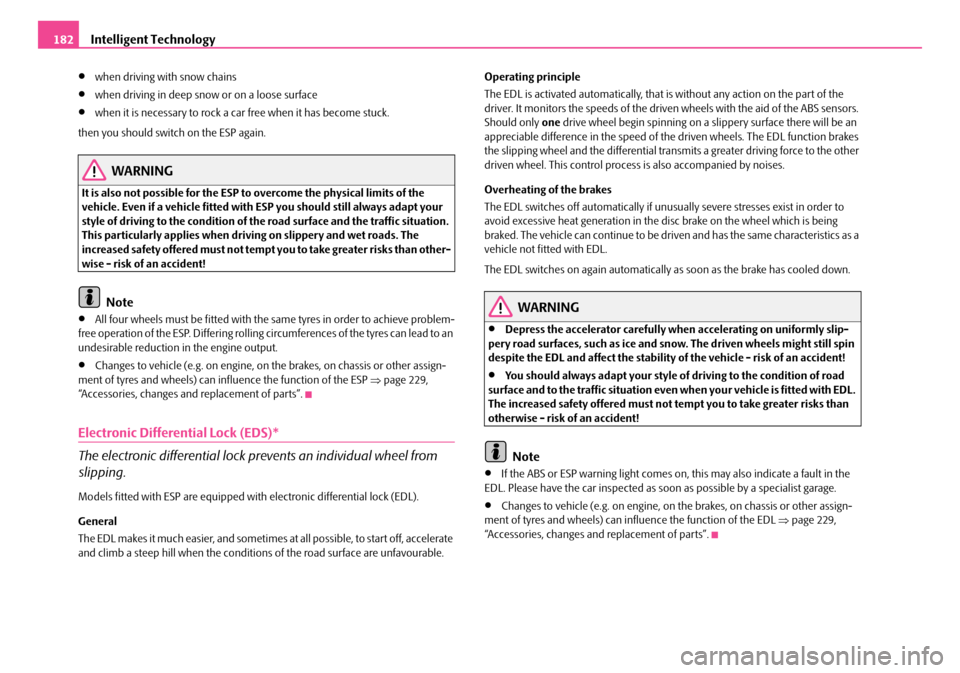
Intelligent Technology
182
•when driving with snow chains
•when driving in deep snow or on a loose surface
•when it is necessary to rock a ca r free when it has become stuck.
then you should switch on the ESP again.
WARNING
It is also not possible for the ESP to overcome the physical limits of the
vehicle. Even if a vehicle fitted with ESP you should still always adapt your
style of driving to the condition of the road surface and the traffic situation.
This particularly applies when driving on slippery and wet roads. The
increased safety offered must not tempt you to take greater risks than other-
wise - risk of an accident!
Note
•All four wheels must be fitted with the same tyres in order to achieve problem-
free operation of the ESP. Differing rolling circumferences of the tyres can lead to an
undesirable reduction in the engine output.
•Changes to vehicle (e.g. on engine, on the brakes, on chassis or other assign-
ment of tyres and wheels) can influence the function of the ESP ⇒page 229,
“Accessories, changes and replacement of parts”.
Electronic Differential Lock (EDS)*
The electronic differential lock pr events an individual wheel from
slipping.
Models fitted with ESP are equipped with electronic differential lock (EDL).
General
The EDL makes it much easier, and sometimes at all possible, to start off, accelerate
and climb a steep hill when the conditio ns of the road surface are unfavourable. Operating principle
The EDL is activated automatically, that is without any action on the part of the
driver. It monitors the speeds of the driven wheels with the aid of the ABS sensors.
Should only
one drive wheel begin spinning on a slippery surface there will be an
appreciable difference in the speed of the driven wheels. The EDL function brakes
the slipping wheel and the differential transmits a greater driving force to the other
driven wheel. This control proces s is also accompanied by noises.
Overheating of the brakes
The EDL switches off automatically if unusually severe stresses exist in order to
avoid excessive heat generation in the disc brake on the wheel which is being
braked. The vehicle can continue to be driven and has the same characteristics as a
vehicle not fitted with EDL.
The EDL switches on again automatically as soon as the brake has cooled down.
WARNING
•Depress the accelerator carefully when accelerating on uniformly slip-
pery road surfaces, such as ice and sn ow. The driven wheels might still spin
despite the EDL and affect the stability of the vehicle - risk of an accident!
•You should always adapt your style of driving to the condition of road
surface and to the traffic situation even when your vehicle is fitted with EDL.
The increased safety offered must not tempt you to take greater risks than
otherwise - risk of an accident!
Note
•If the ABS or ESP warning light comes on, this may also indicate a fault in the
EDL. Please have the car inspected as s oon as possible by a specialist garage.
•Changes to vehicle (e.g. on engine, on the brakes, on chassis or other assign-
ment of tyres and wheels) can in fluence the function of the EDL ⇒page 229,
“Accessories, changes and replacement of parts”.
NKO A5 20 MR08.book Page 182 Wednesday, April 11, 2007 2:54 PM